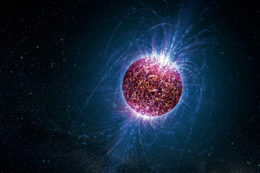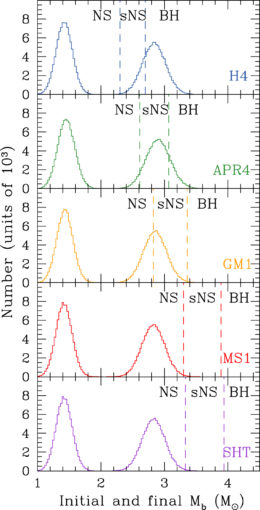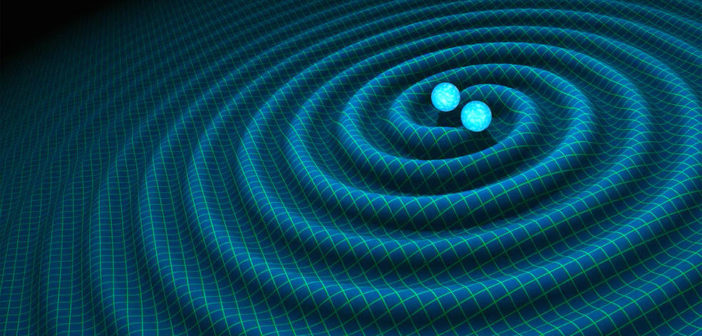
A rapidly spinning, highly magnetized neutron star is one possible outcome when two smaller neutron stars merge. [Casey Reed/Penn State University]
Neutron Star or Black Hole?
So far, the only systems from which we’ve detected gravitational waves are merging black holes. But other compact-object binaries exist and are expected to merge on observable timescales — in particular, binary neutron stars. When two neutron stars merge, the resulting object falls into one of three categories:
- a stable neutron star,
- a black hole, or
- a supramassive neutron star, a large neutron star that’s supported by its rotation but will eventually collapse to a black hole after it loses angular momentum.

Histograms of the initial (left) and final (right) distributions of objects in the authors’ simulations, for five different equations of state. Most cases resulted primarily in the formation of neutron stars (NSs) or supramassive neutron stars (sNSs), not black holes (BHs). [Piro et al. 2017]
In a recent study, a team of scientists led by Anthony Piro (Carnegie Observatories) estimated which of these outcomes we should expect for mergers of binary neutron stars. The team’s results — along with future observations of binary neutron stars — may help us to eventually pin down the equation of state for neutron stars.
Merger Outcomes
Piro and collaborators used relativistic calculations of spinning and non-spinning neutron stars to estimate the mass range that neutron stars would have for several different realistic equations of state. They then combined this information with Monte Carlo simulations based on the mass distribution of neutron-star binaries in our galaxy. From these simulations, Piro and collaborators could predict the distribution of fates expected for merging neutron-star binaries, given different equations of state.
The authors found that the fate of the merger could vary greatly depending on the equation of state you assume. Intriguingly, all equations of state resulted in a surprisingly high fraction of systems that merged to form a neutron star or a supramassive neutron star — in fact, four out of the five equations of state predicted that 80–100% of systems would result in a neutron star or a supermassive neutron star.
Lessons from Observations

The frequency bands covered by various current and planned gravitational wave observatories. Advanced LIGO has the right frequency coverage to be able to explore a neutron-star remnant — if the signal is loud enough. [Christopher Moore, Robert Cole and Christopher Berry]
Even if we can’t observe the remnant’s behavior after it forms, we can still compare the distribution of remnants that we observe in the future to the predictions made by Piro and collaborators. This will potentially allow us to constrain the neutron-star equation of state, revealing the physics of neutron-star interiors even without direct observations.
Citation
Anthony L. Piro et al 2017 ApJL 844 L19. doi:10.3847/2041-8213/aa7f2f

4 Comments
Pingback: what happens when to NSs merge?
Pingback: The Fate of Merging Neutron Stars – Bruno Giacomazzo
Pingback: 59 (Fifty-nine!) Binary Neutron Star Merger Simulations | astrobites
Pingback: 59 (Fifty-Nine!) Binary Neutron Star Merger Simulations